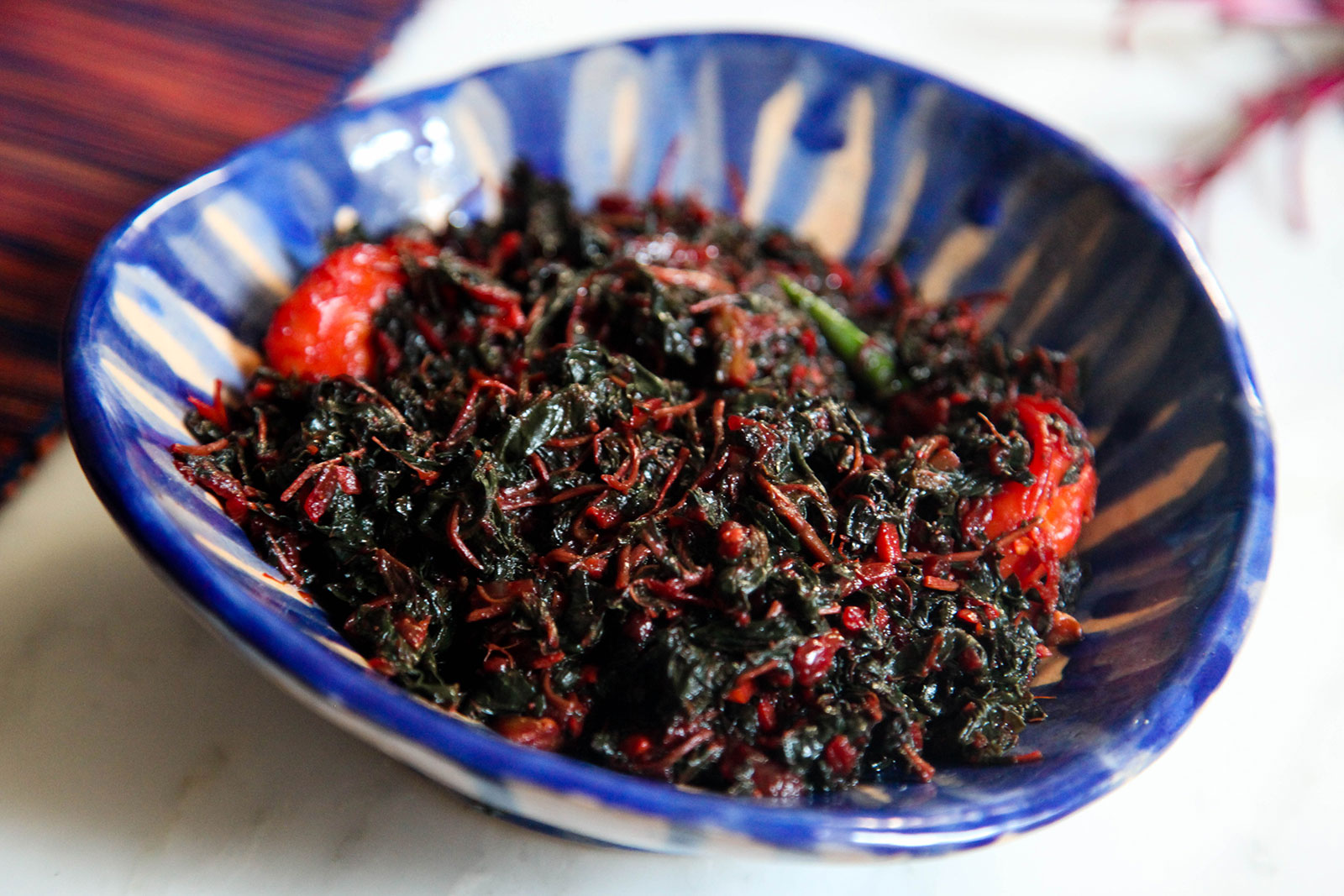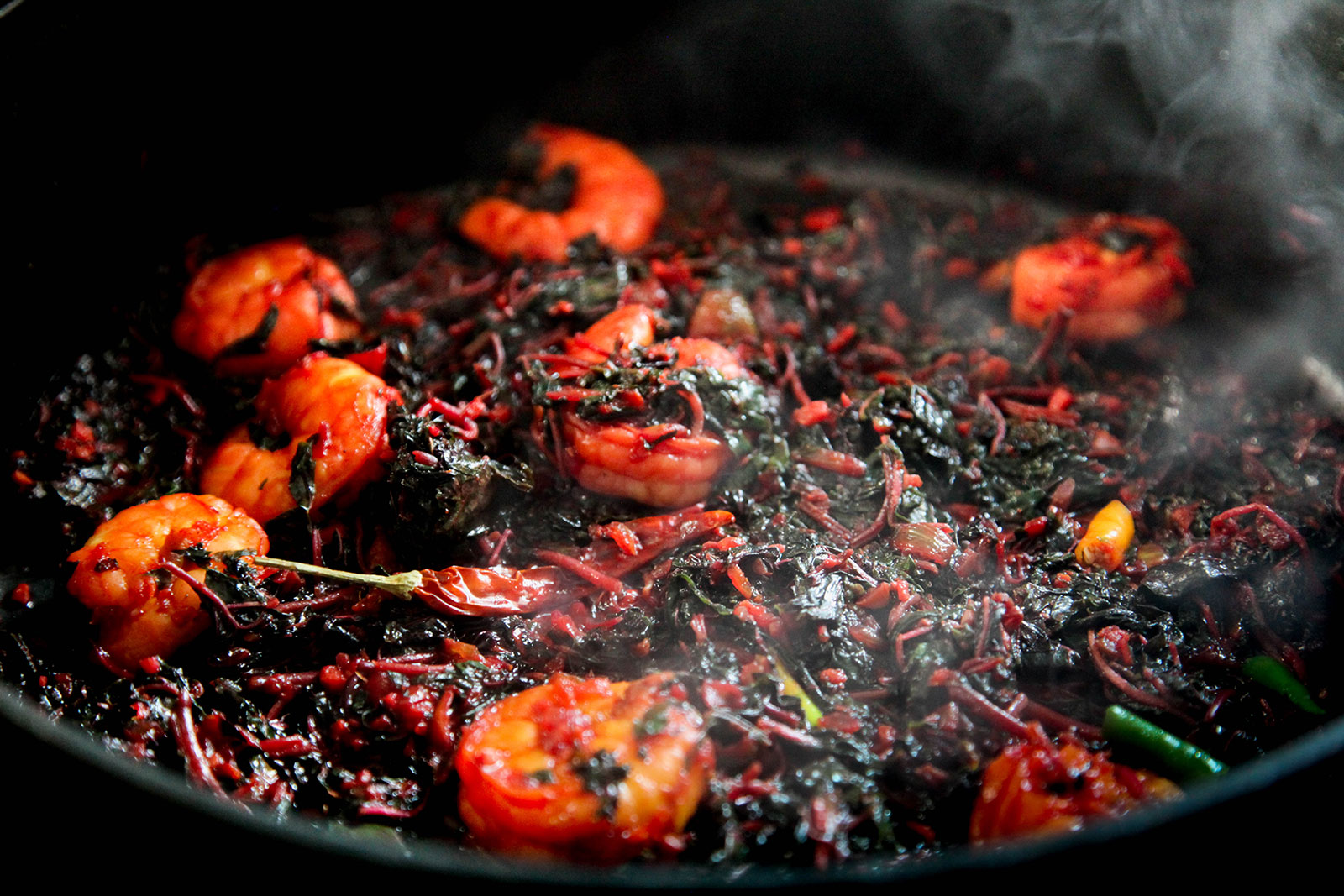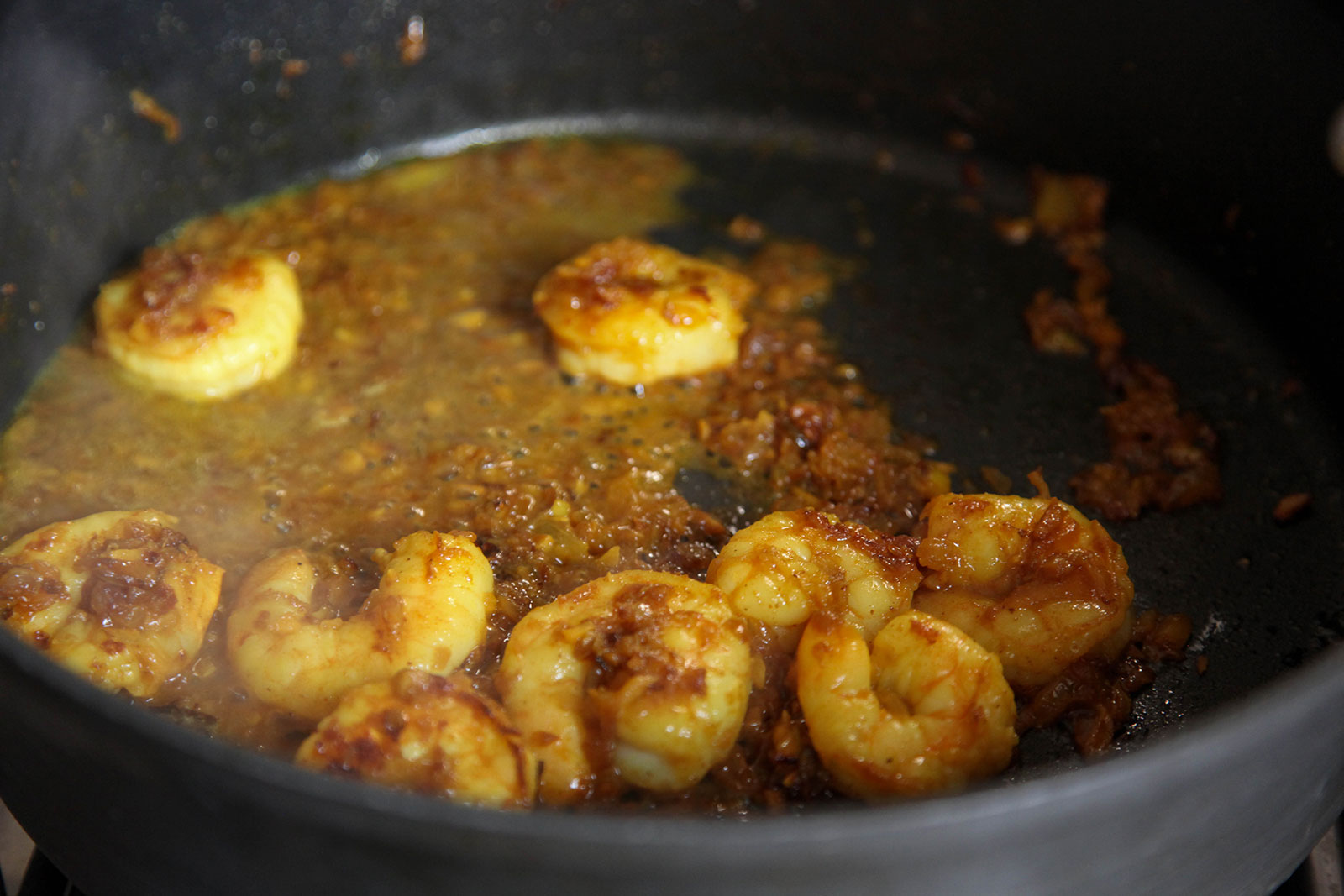Lal Shak – Amaranth (Bangladeshi style) with Onions, Garlic, Ginger & Shrimp

Amaranth is considered a superfood. It’s loaded with vitamins (1 cup of cooked leaves has 90% of vitamin C for the day, over 70% of vitamin A, plus plenty of other vitamins), antioxidants, minerals (has an especially high concentration of manganese which is essential for brain function). It’s rich in fiber and protein (good for vegetarians), has anti-inflammatory properties, helps lower cholesterol, is good for the heart, research is starting to indicate anti-cancerous properties… the health benefits list goes on. It’s used traditionally in various cultures to treat a variety of ailments. It’s amazing what this simple vegetable can do. The amaranth leaves taste somewhat like spinach – in Bangladesh it’s called lal shak, which literally translates to “red spinach” in Bengali. The color is gorgeous, a deep rich maroonish red. And it’s very simple to cook. In our house they would cook amaranth with onions, ginger, garlic, turmeric and shrimp – it was absolutely delicious!

As a child I loved vegetables, especially all the different varieties of “spinach” that would become available over the seasons. And my absolute favorite of all the types of spinach was lal shak. In fact I would beg for it to be cooked almost daily when it was in season. My dad was well aware of my love for lal shak, and he would get it as soon as it would become available in the markets. We would eat it for lunch usually. There were always 5 or 6 varieties of dishes on the table, but I would immediately load my plate with rice, dal and lal shak. Only after I satisfied my craving, I would move onto the fish and chicken dishes. I think that’s still the best way to eat lal shak – have it with some plain rice and simple dal.

For years after I started living in the US, it was impossible to find fresh amaranth. And I really missed it. While I would visit my parents in the summers, they were living in Kenya at that point and there was no amaranth there. Later when they moved back to Bangladesh, I would visit unfortunately in the season when lal shak wasn’t available. So there were years and years when I didn’t get to eat lal shak at all. In New York, I would trek over to the Jackson Heights area of Queens where there were Indian and Bangladeshi grocery stores and ask them for lal shak. Nothing. It became like the holy grail for me. Every summer I searched for amaranth – in those stores, at farmers markets. It was like a time of famine, the distant memory of lal shak instead of fading became more and more intense. One year when I was visiting my mom, I even wrote down her recipe and method for making lal shak; even though I had no real chance of locating any in New York, I still held out hope that one day I would find lal shak here. And then finally a few years ago, I was walking in Jackson Heights when suddenly I saw a street-cart vegetable vendor with what looked like a small pile of lal shak. I remember that instant vividly. I stood still, hardly daring to believe what I was seeing. I moved close and stared at the bundles. Finally I asked the Bangladeshi man was it was. He said “lal shak”. I bought a bunch, rushed home, dug out the handwritten recipe of my mom’s that I had been saving for years, and cooked it. Food is the link between the past and the present, and finally that part of me that had been craving this food from a wonderful carefree time of my life, felt somewhat restored.

Since then, every summer lal shak has been showing up in New York. It’s available widely nowadays in most Bangladeshi stores in Jackson Heights. July and August are the months when multiple stores carry lal shak. And this summer, for the first time, vendors at the farmers markets in Manhattan have been carrying bunches of amaranth leaves too. In my excitement to find amaranth at my local farmers markets (which the vendors were selling as edible amaranth), I bought 2 bunches from two different farmers markets. They looked a little different though, much more vibrant in color. When I cooked them, I discovered that they were terribly bitter. I actually had to throw them out. Apparently that’s a variety of amaranth leaves, that though edible, needs to be soaked in water and boiled to remove the bitter coating.

How to tell the difference between delicious edible amaranth leaves (lal shak) and bitter amaranth
I’ve learned that there are about 70 types of amaranth, of which 17 are edible. Since they generally go by the name of amaranth when sold, it’s difficult to know which ones are the bitter amaranth and which are the delicious amaranth of the South Asian variety. You’ll have to know what the leaves look like. Since I still had a bunch of the bitter type left, I am showing them side-by-side in the photo above for comparison. The bitter type to avoid is on the left, the right version to cook (the “lal shak” variety) is on the right. You can see the bitter ones have a much more vibrant and brighter color, the leaves and stems are almost the same shade, and the leaves are rather long with pointed tips. The south asian “lal shak” amaranth have roundish leaves (not pointed), the leaves are a darker shade than the brighter stems. These are sometimes available in Bangladeshi, Indian grocery stores.
“Koshano” technique
The recipe here is my mom’s, it’s the method she had described to me years ago that I had written down. It’s really fantastic. You can cook it without shrimp and it will still be delicious (I love it with shrimp since that’s the way it was cooked when I was growing up).
It’s important to spend some effort cooking the spice mix of onions, ginger and garlic in the way I’ve described it – this technique is known as “koshano” in Bengali and is described in steps 8 and 9 in the “Method” section below. Just like risotto won’t taste like risotto if you do shortcuts, in order to get the delicious taste (instead of an unpleasant raw-spice taste) one needs to koshao the spices first. That’s what gives the authentic taste of Bengali food.












Lal Shak – Amaranth (Bangladeshi style) with Onions, Garlic, Ginger & Shrimp
SERVES: 2 (serves 4 as a side dish)
INGREDIENTS
- 1.5 pounds fresh amaranth/lal shak leaves with stems (about 4 cups packed chopped leaves; yields 1 cup cooked amaranth)
- 8-10 large shrimp, peeled and cleaned
- 1 heaped cup chopped onion
- 1.5 tablespoon chopped garlic
- 1 heaped tablespoon chopped ginger
- 1 bay leaf (optional)
- 1 teaspoon turmeric
- 1-2 green chilies sliced and cut in half
- 1 dried red chili
- 2 tablespoons oil
- 1/2 teaspoon salt (or to taste)
METHOD
- Shell the shrimp and soak in a bowl of water for about 5 minutes while preparing the rest of the ingredients. Drain water and thoroughly rinse the shrimp under cold water (you can skip this step if you want; I do it because most store-bought shrimp is pre-frozen and this helps get rid of the fishy/shrimpy smell).
- Remove the amaranth leaves from the stems. Rinse the leaves thoroughly under water in a colander, drain. (In this recipe I’m not cooking the stems. You can cook the stems if you wish; if so, after removing the leaves cut the stems into 1 inch pieces and cook them after you add the shrimp. Cover and cook for about 10-15 minutes till stems are soft, before adding the leaves).
- Bunch the washed leaves together with your hand on a cutting board, and slice across lengthwise to cut into pieces.
- Rinse the green chilies, slice in half and set aside.
- Finely chop onion, ginger, and garlic.
- Heat a wide bottomed pan over medium heat. Add 2 tablespoons oil, heat for about a minute. Add onions, garlic, ginger, stir fry until onions are translucent and starting to yellow (about 5 mins).
- Add turmeric and salt, and bayleaf (if you’re using it), stir fry for a minute.
- Add a quarter cup water, stir. Let it cook until water is absorbed.
- When the water is absorbed, add another quarter cup water, stir. Repeat this process about 4 times. While the water will end up totaling to 1 cup, don’t add too much water at one go. You have to follow this process to allow the onion and raw spices smell to transform to a mellow delicious taste. You’ll see the texture of the onions transforming. This process is known as the “koshano technique”.
- When the 4th round of water has been absorbed, add the shrimp (pour the water out from the shrimp first and then add the liquid-less shrimp). Stir fry for a couple of minutes.
- Add 1/2 cup of water, stir.
- Add the chopped amaranth leaves, green chilies and dried red chili. Cook for about 7-10 minutes, stirring to make sure spinach doesn’t burn. Turn off heat, taste for salt. Serve.


❤️